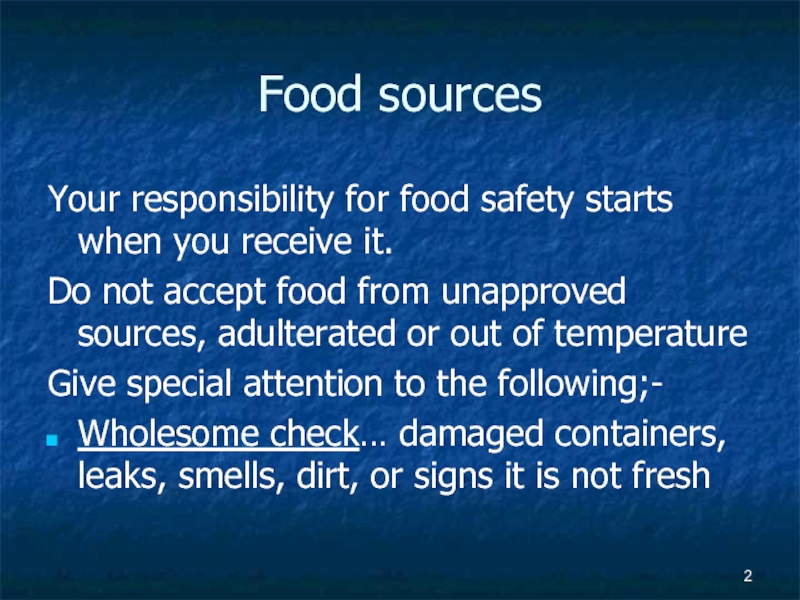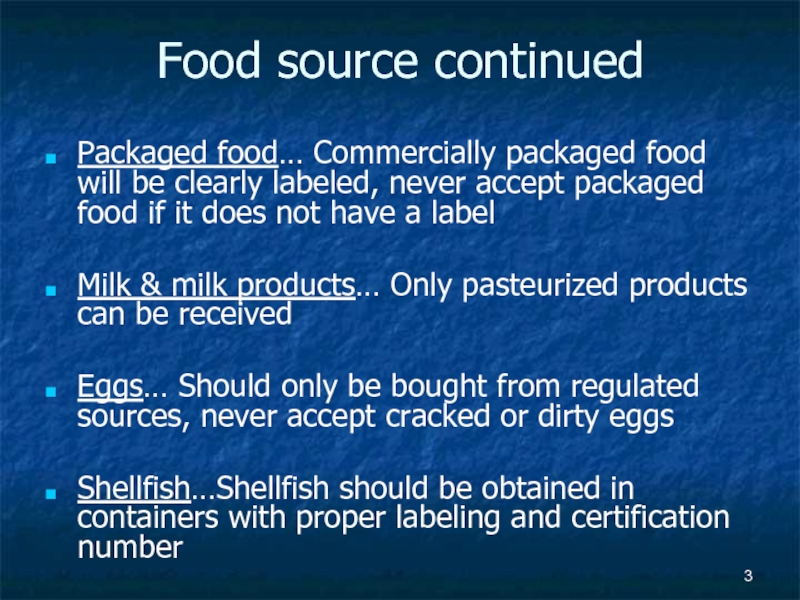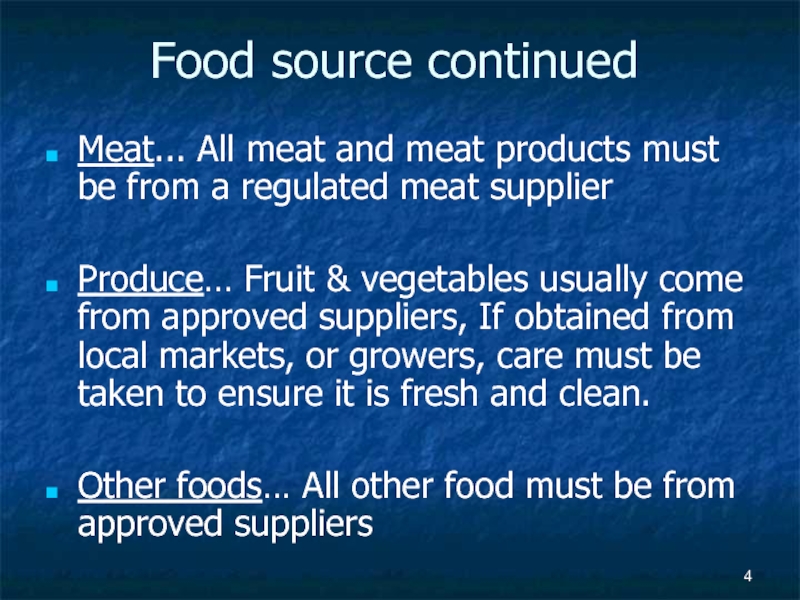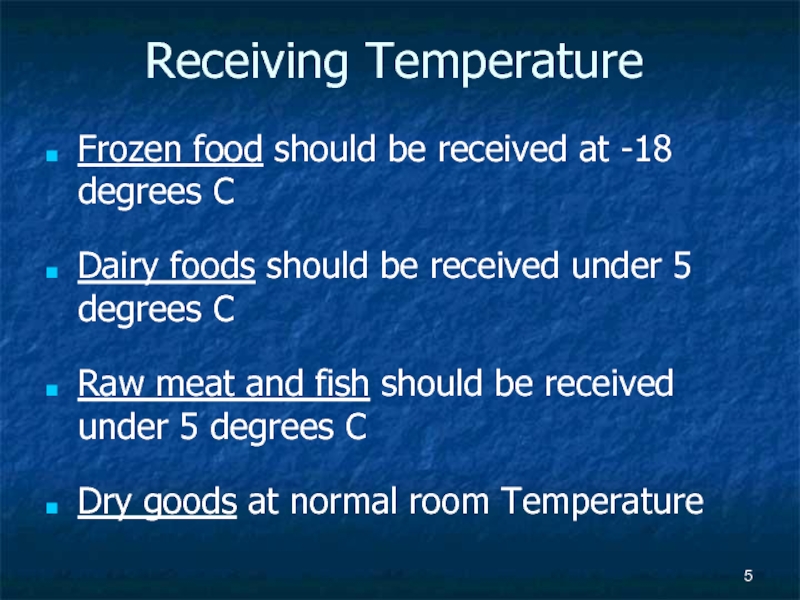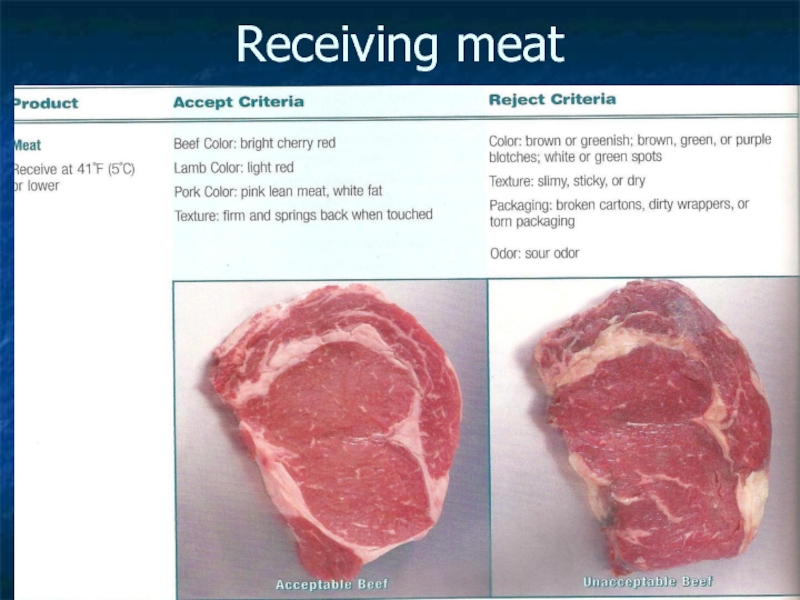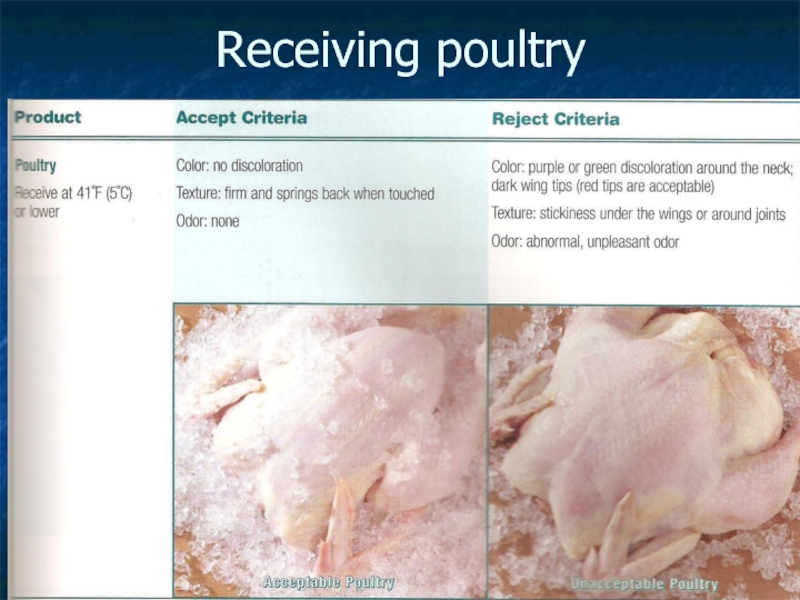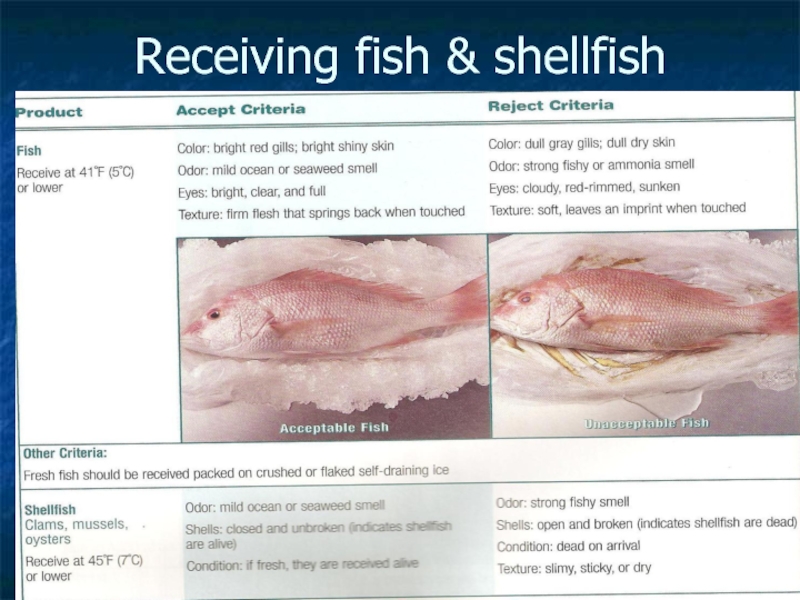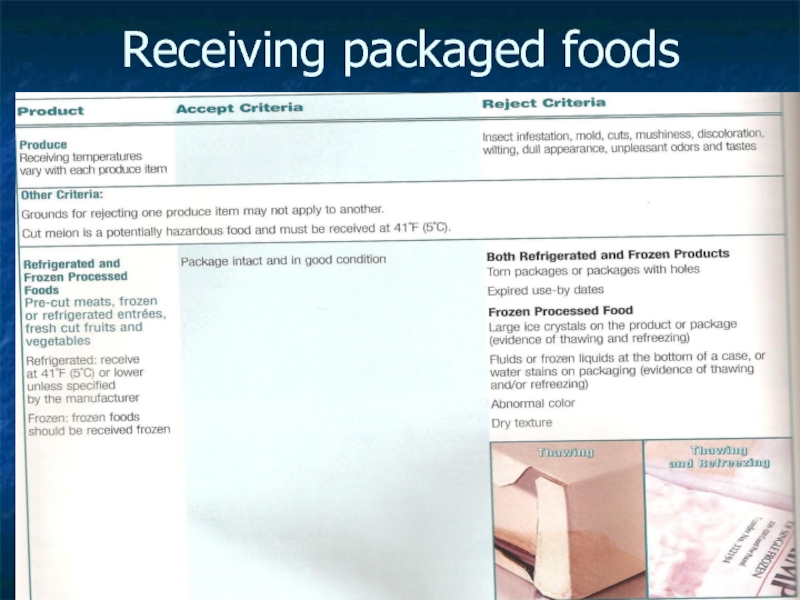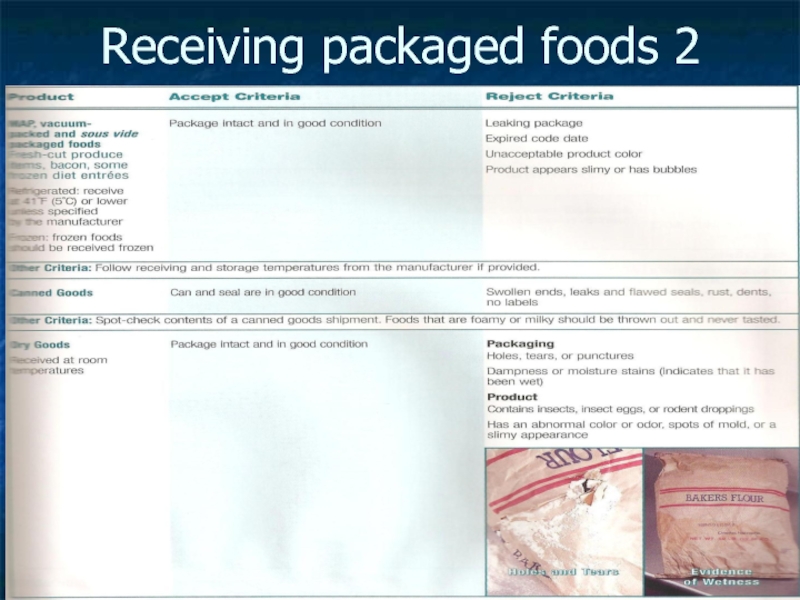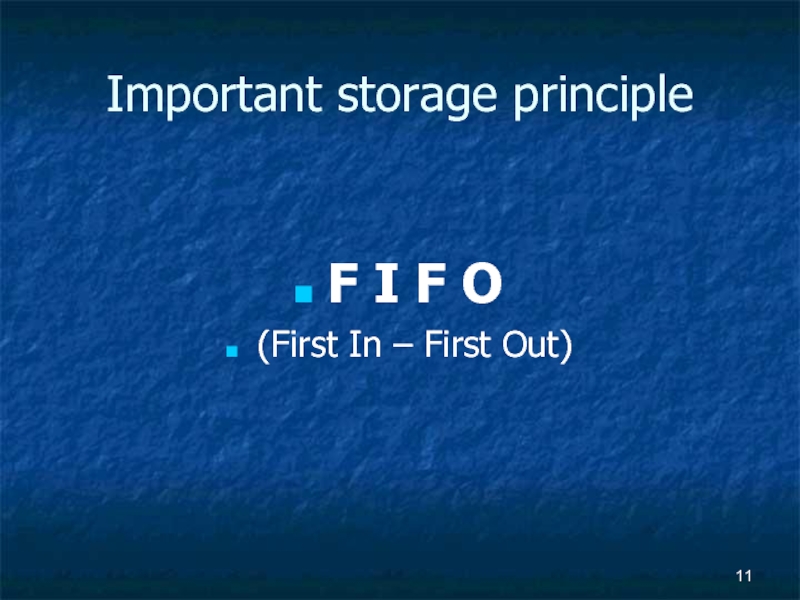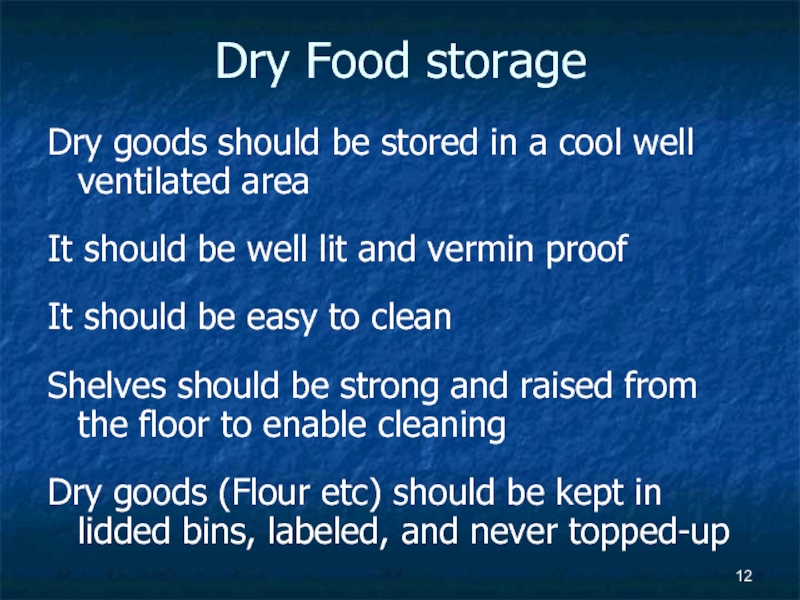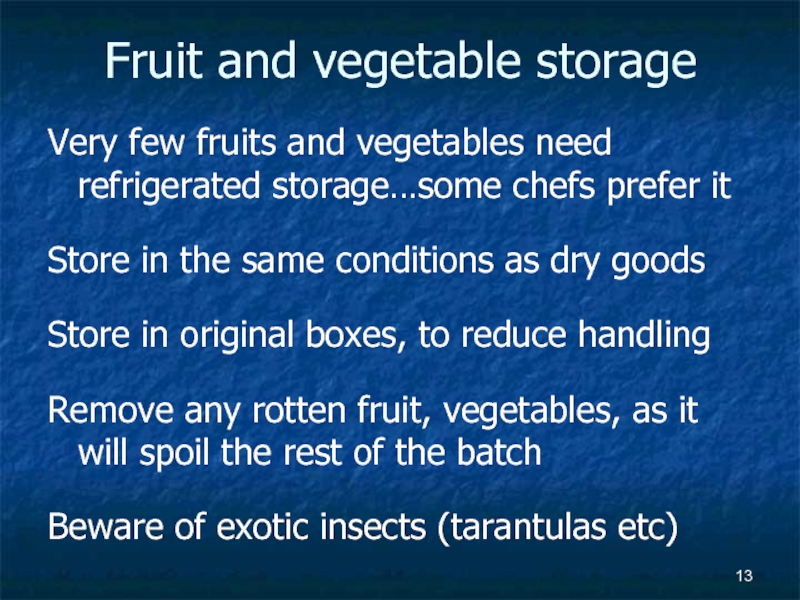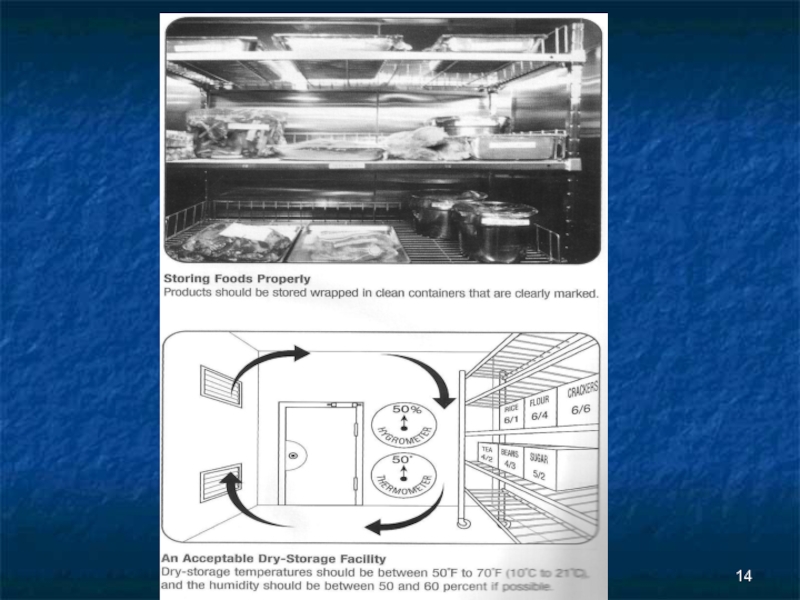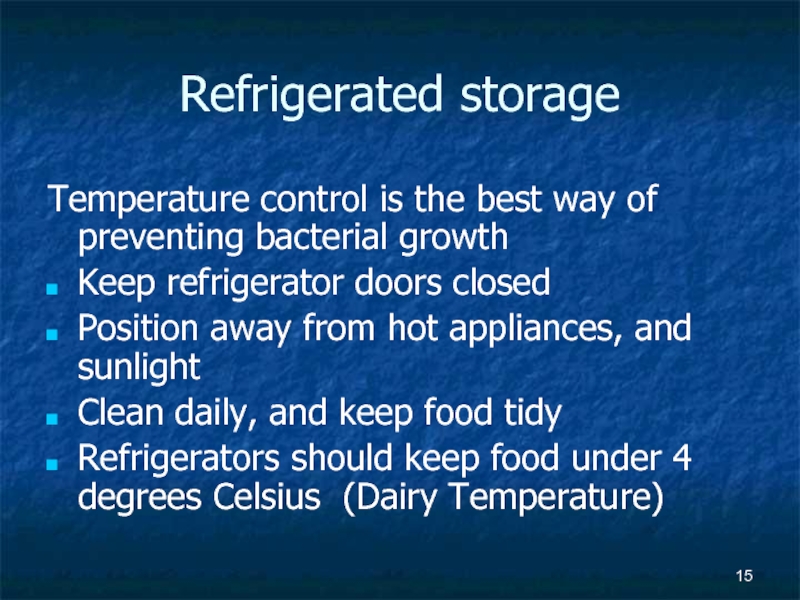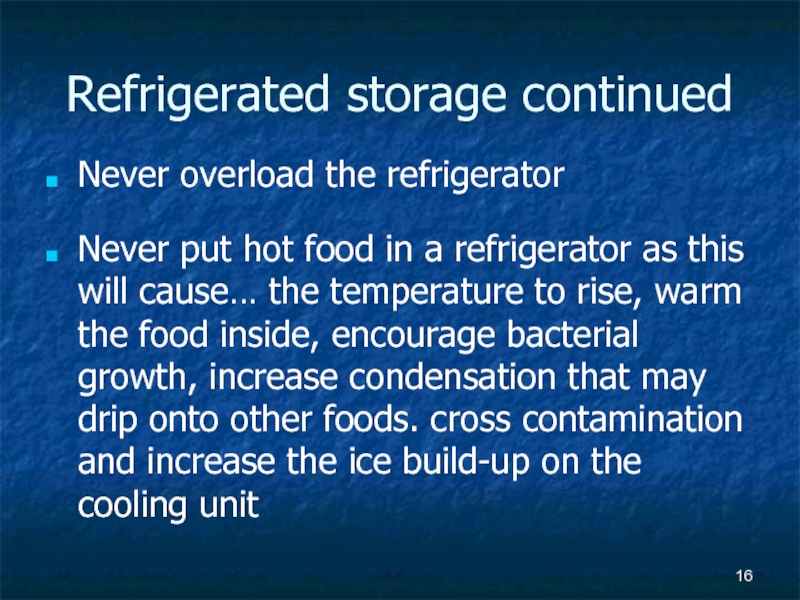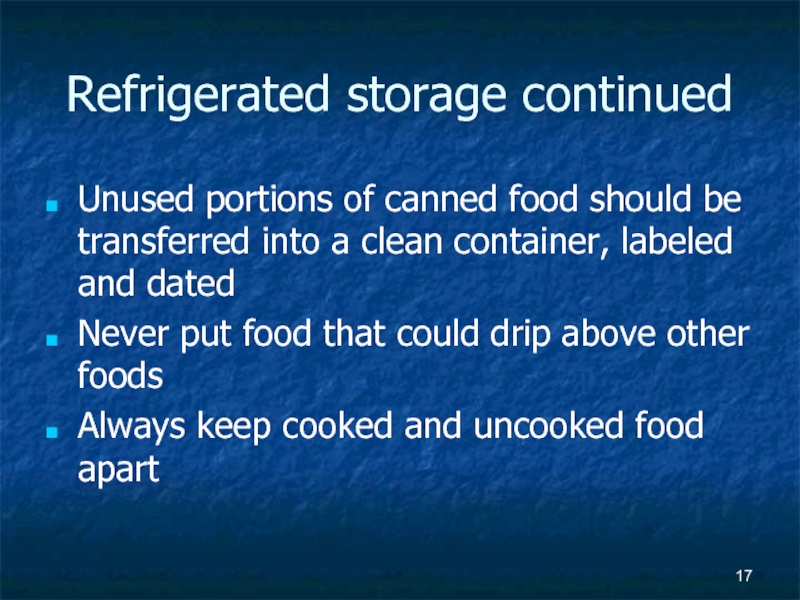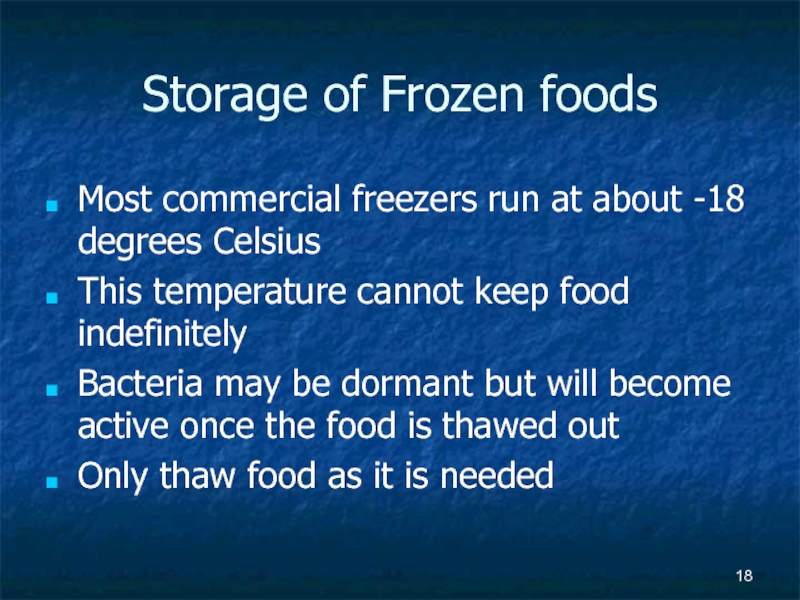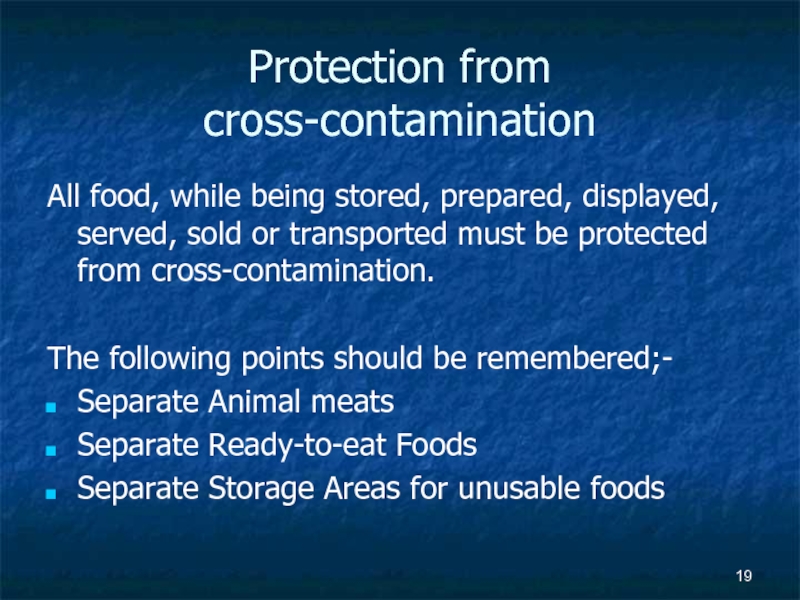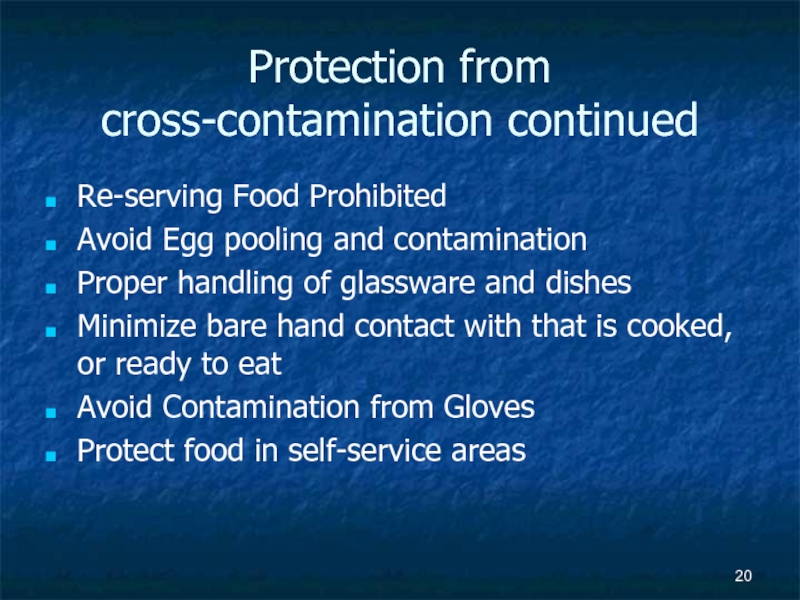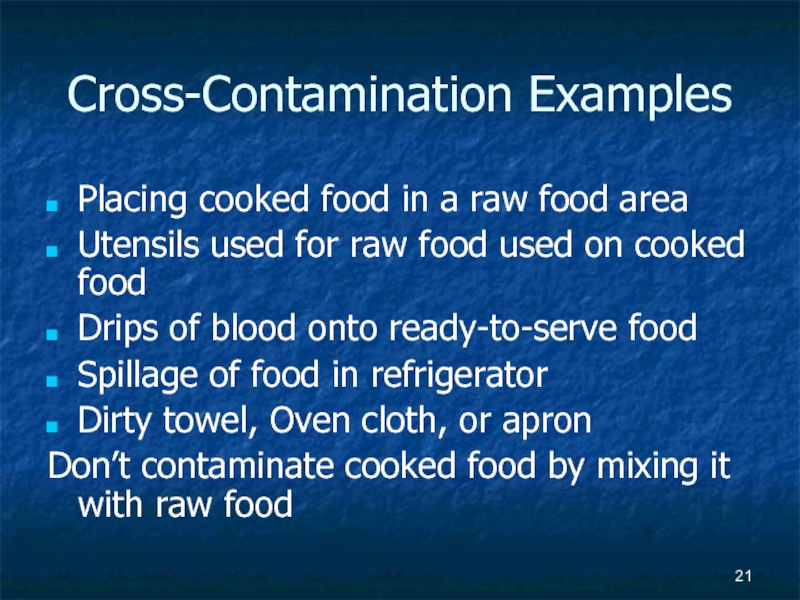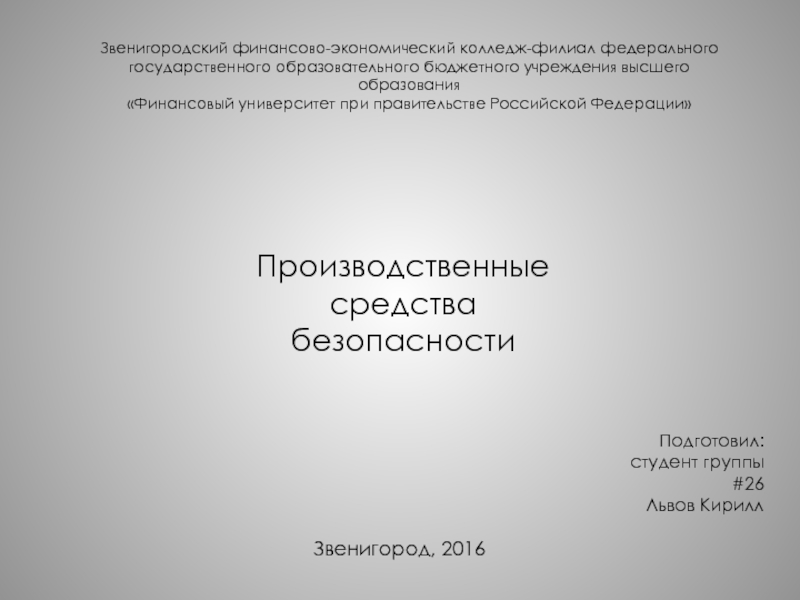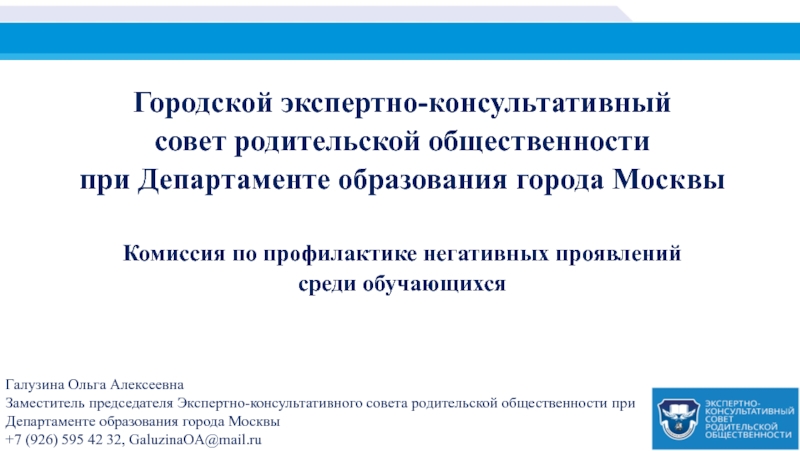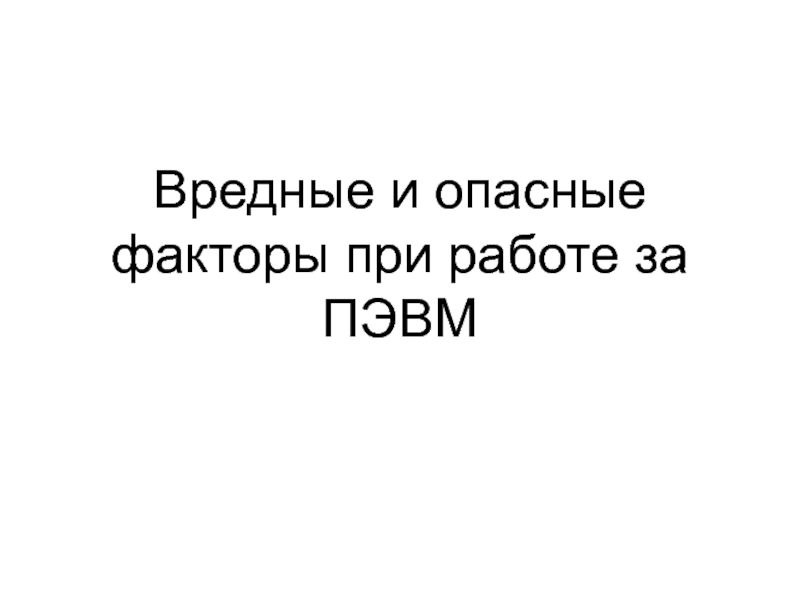- Главная
- Разное
- Дизайн
- Бизнес и предпринимательство
- Аналитика
- Образование
- Развлечения
- Красота и здоровье
- Финансы
- Государство
- Путешествия
- Спорт
- Недвижимость
- Армия
- Графика
- Культурология
- Еда и кулинария
- Лингвистика
- Английский язык
- Астрономия
- Алгебра
- Биология
- География
- Детские презентации
- Информатика
- История
- Литература
- Маркетинг
- Математика
- Медицина
- Менеджмент
- Музыка
- МХК
- Немецкий язык
- ОБЖ
- Обществознание
- Окружающий мир
- Педагогика
- Русский язык
- Технология
- Физика
- Философия
- Химия
- Шаблоны, картинки для презентаций
- Экология
- Экономика
- Юриспруденция
Food sources and protection. (Chapter 4) презентация
Содержание
- 1. Food sources and protection. (Chapter 4)
- 2. Food sources Your responsibility for food safety
- 3. Food source continued Packaged food… Commercially packaged
- 4. Food source continued Meat... All meat and
- 5. Receiving Temperature Frozen food should be received
- 6. Receiving meat
- 7. Receiving poultry
- 8. Receiving fish & shellfish
- 9. Receiving packaged foods
- 10. Receiving packaged foods 2
- 11. Important storage principle F I F O (First In – First Out)
- 12. Dry Food storage Dry goods should be
- 13. Fruit and vegetable storage Very few fruits
- 15. Refrigerated storage Temperature control is the best
- 16. Refrigerated storage continued Never overload the
- 17. Refrigerated storage continued Unused portions of canned
- 18. Storage of Frozen foods Most commercial freezers
- 19. Protection from cross-contamination All food, while
- 20. Protection from cross-contamination continued Re-serving Food
- 21. Cross-Contamination Examples Placing cooked food in a
Слайд 2Food sources
Your responsibility for food safety starts when you receive it.
Do
not accept food from unapproved sources, adulterated or out of temperature
Give special attention to the following;-
Wholesome check… damaged containers, leaks, smells, dirt, or signs it is not fresh
Give special attention to the following;-
Wholesome check… damaged containers, leaks, smells, dirt, or signs it is not fresh
Слайд 3Food source continued
Packaged food… Commercially packaged food will be clearly labeled,
never accept packaged food if it does not have a label
Milk & milk products… Only pasteurized products can be received
Eggs… Should only be bought from regulated sources, never accept cracked or dirty eggs
Shellfish…Shellfish should be obtained in containers with proper labeling and certification number
Milk & milk products… Only pasteurized products can be received
Eggs… Should only be bought from regulated sources, never accept cracked or dirty eggs
Shellfish…Shellfish should be obtained in containers with proper labeling and certification number
Слайд 4Food source continued
Meat... All meat and meat products must be from
a regulated meat supplier
Produce… Fruit & vegetables usually come from approved suppliers, If obtained from local markets, or growers, care must be taken to ensure it is fresh and clean.
Other foods… All other food must be from approved suppliers
Produce… Fruit & vegetables usually come from approved suppliers, If obtained from local markets, or growers, care must be taken to ensure it is fresh and clean.
Other foods… All other food must be from approved suppliers
Слайд 5Receiving Temperature
Frozen food should be received at -18 degrees C
Dairy foods
should be received under 5 degrees C
Raw meat and fish should be received under 5 degrees C
Dry goods at normal room Temperature
Raw meat and fish should be received under 5 degrees C
Dry goods at normal room Temperature
Слайд 12Dry Food storage
Dry goods should be stored in a cool well
ventilated area
It should be well lit and vermin proof
It should be easy to clean
Shelves should be strong and raised from the floor to enable cleaning
Dry goods (Flour etc) should be kept in lidded bins, labeled, and never topped-up
It should be well lit and vermin proof
It should be easy to clean
Shelves should be strong and raised from the floor to enable cleaning
Dry goods (Flour etc) should be kept in lidded bins, labeled, and never topped-up
Слайд 13Fruit and vegetable storage
Very few fruits and vegetables need refrigerated storage…some
chefs prefer it
Store in the same conditions as dry goods
Store in original boxes, to reduce handling
Remove any rotten fruit, vegetables, as it will spoil the rest of the batch
Beware of exotic insects (tarantulas etc)
Store in the same conditions as dry goods
Store in original boxes, to reduce handling
Remove any rotten fruit, vegetables, as it will spoil the rest of the batch
Beware of exotic insects (tarantulas etc)
Слайд 15Refrigerated storage
Temperature control is the best way of preventing bacterial growth
Keep
refrigerator doors closed
Position away from hot appliances, and sunlight
Clean daily, and keep food tidy
Refrigerators should keep food under 4 degrees Celsius (Dairy Temperature)
Position away from hot appliances, and sunlight
Clean daily, and keep food tidy
Refrigerators should keep food under 4 degrees Celsius (Dairy Temperature)
Слайд 16Refrigerated storage continued
Never overload the refrigerator
Never put hot food in
a refrigerator as this will cause… the temperature to rise, warm the food inside, encourage bacterial growth, increase condensation that may drip onto other foods. cross contamination and increase the ice build-up on the cooling unit
Слайд 17Refrigerated storage continued
Unused portions of canned food should be transferred into
a clean container, labeled and dated
Never put food that could drip above other foods
Always keep cooked and uncooked food apart
Never put food that could drip above other foods
Always keep cooked and uncooked food apart
Слайд 18Storage of Frozen foods
Most commercial freezers run at about -18 degrees
Celsius
This temperature cannot keep food indefinitely
Bacteria may be dormant but will become active once the food is thawed out
Only thaw food as it is needed
This temperature cannot keep food indefinitely
Bacteria may be dormant but will become active once the food is thawed out
Only thaw food as it is needed
Слайд 19Protection from
cross-contamination
All food, while being stored, prepared, displayed, served, sold
or transported must be protected from cross-contamination.
The following points should be remembered;-
Separate Animal meats
Separate Ready-to-eat Foods
Separate Storage Areas for unusable foods
The following points should be remembered;-
Separate Animal meats
Separate Ready-to-eat Foods
Separate Storage Areas for unusable foods
Слайд 20Protection from
cross-contamination continued
Re-serving Food Prohibited
Avoid Egg pooling and contamination
Proper handling
of glassware and dishes
Minimize bare hand contact with that is cooked, or ready to eat
Avoid Contamination from Gloves
Protect food in self-service areas
Minimize bare hand contact with that is cooked, or ready to eat
Avoid Contamination from Gloves
Protect food in self-service areas
Слайд 21Cross-Contamination Examples
Placing cooked food in a raw food area
Utensils used for
raw food used on cooked food
Drips of blood onto ready-to-serve food
Spillage of food in refrigerator
Dirty towel, Oven cloth, or apron
Don’t contaminate cooked food by mixing it with raw food
Drips of blood onto ready-to-serve food
Spillage of food in refrigerator
Dirty towel, Oven cloth, or apron
Don’t contaminate cooked food by mixing it with raw food

